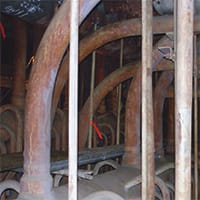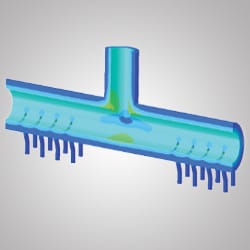Superheater & Reheater Outlet Headers


High temperature headers are among the most difficult and critical components for risk assessment. They bring together questions of weld integrity, defect assessment and creep-fatigue damage in thick sections. Recommendations which reflect the real risks and options are key.
Header Risk Management
A systematic approach to header reliability requires Level I scoping techniques to identify at-risk headers, followed by more detailed approaches to define specific recommendations. Superheater and reheater outlet headers are usually thought of as the highest risk headers. This is not always true. Seam-welded superheater platen outlet headers could occupy the top slot, which is why an initial survey to rank headers in terms of likely risk is recommended.
Assessment & Remaining Life Prediction
The new API-1/ASME FFS-1 post-construction standard provides data and a framework for pressure part risk assessment. Risk-based assessments can provide a rational basis for dealing with the meaning of “exceeding minimum rupture life”.
The level of information available defines the amount that can be done. Typical examples are:
- Design data only – Assessment is possible if there is a basis for believing that operating conditions are less severe than design conditions. Ranking of header risk is possible.
- Design data + Distributed Control System (DCS) data – Life prediction based on minimum properties and typical header temperature variation has some basis.
- Design data + DCS + thermocouple data – Maximum header temperature is known and steady load assessment based on minimum properties is possible. Probabilistic statements to justify inspection intervals may be made.
- Design data + DCS + thermocouple data (steady and cyclic) + material data – Remaining life estimates can be performed with the most confidence. What makes life prediction possible is knowledge of the creep properties of header material.
Determining Header Condition
Due to the statistical spread of properties, calculation of header remaining life can only be a probabilistic exercise unless physical evidence is available. Metallurgical evidence can provide an indication, as does swelling. Welds (seam or girth) coinciding with tube penetrations are often the first areas of creep damage. On thicker headers, thermal creep-fatigue can be a factor. Top-to-bottom differentials can give rise to distinctively oriented cracking. Where creep damage is identified or suspected, removing samples and subjecting them to accelerated creep and rupture testing provides the strongest basis for determining remaining life. Testing overcomes the problem of the unknown initial creep strength, since the test directly measures the property of interest. Extracting a core sample, as though a tube penetration was required, is the easiest sampling technique to repair. Samples from the core are then fabricated into a test sample for creep and rupture testing.
Header Assessment May Be Required When:
- Header life is known to be comparable with or greater than minimum rupture life based on design stress and temperature.
- Inspection has uncovered evidence of reduced wall thickness, creep damage, cracking or swelling.
Estimation of remaining life of high temperature headers follows a number of possible paths depending on the available information. The following possibilities are based on the use of API-579/ASME-FFS mechanical properties data.
- Remaining life based on design or operating data
- Prediction of swelling
- Probability of failure before the next inspection
- Crack growth calculations and leak-before-break or fracture prediction
Typical information requirements necessary to make an assessment include:
- Design drawing showing material, design dimensions, position of welds, design temperature and pressure
- As manufactured drawing (actual thickness)
- DCS data showing operating pressure and steam temperature for steady and cyclic operation
- Nipple thermocouple data showing the side-side temperature variation and start up-shut down cycle temperatures.
- Inspection data confirming existence and position of seamwelds, OD and thickness measurements,
- UT of welds, on-site metallography
- Results of accelerated creep testing of samples
Decisions & Options
We can provide a defensible basis for decisions such as:
- Inspection interval, inspection techniques
- Time to schedule replacements
- De-rating to reduce risks until next outage
- Temperature and strain monitoring
Due to the complexity of header remaining life predictions, leverage of plant experience and expertise is essential. We will work closely with plant personnel to develop a comprehensive plan for header risk management.



